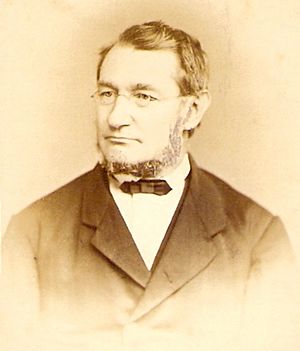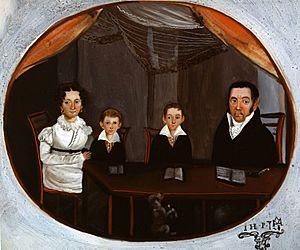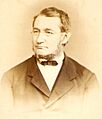Julius von Mayer facts for kids
Quick facts for kids
Julius Robert von Mayer
|
|
|---|---|
 |
|
| Born |
Julius Robert Mayer
25 November 1814 |
| Died | 20 March 1878 (aged 63) Heilbronn, German Empire
|
| Nationality | German |
| Alma mater | University of Tübingen |
| Known for | First law of thermodynamics Mechanical equivalent of heat Mayer's reagent Mayer's relation |
| Awards | Copley Medal (1871) Poncelet Prize (1869) |
| Scientific career | |
| Fields | Physics |
| Influenced | William Thomson |
Julius Robert von Mayer (born November 25, 1814 – died March 20, 1878) was a German physician, chemist, and physicist. He was one of the people who helped create the field of thermodynamics, which studies heat and energy.
Mayer is famous for stating in 1841 one of the first ideas about the conservation of energy. This idea is now known as a key part of the first law of thermodynamics. It means that "energy can be neither created nor destroyed." In 1842, Mayer also explained that a chemical process called oxidation is the main way living things get their energy. He also suggested that plants change light into chemical energy.
Contents
Early Life and Studies
Julius Robert Mayer was born on November 25, 1814, in Heilbronn, Germany. His father was a pharmacist, someone who prepares and sells medicines.
He studied medicine at the University of Tübingen. In 1838, he earned his doctorate degree. After spending some time in Paris, France, he worked as a ship's doctor. He traveled on a Dutch sailing ship to Jakarta, a city in Indonesia.
During this journey, Mayer noticed something interesting. He saw that stormy ocean waves were warmer than calm parts of the sea. This observation made him think deeply about how heat works and how it relates to other types of energy. After returning home in 1841, he focused on solving this puzzle.
Developing New Ideas
Even as a child, Mayer was very curious about how things worked. He loved doing experiments in physics and chemistry. He enjoyed building electrical devices and air pumps.
In 1837, Mayer got into some trouble at the university. This led him to travel to Switzerland, France, and the Dutch East Indies. During his travels, he became more interested in mathematics and engineering. In 1841, Mayer returned to Heilbronn to work as a doctor, but physics became his main passion.
In June 1841, he finished his first scientific paper. It was about how forces can be measured. However, other scientists did not pay much attention to it.
Mayer then became very interested in heat and its movement. He was the first to give a number for the mechanical equivalent of heat. This idea explains how mechanical energy (like movement) can turn into heat energy. He also described oxidation as the main source of energy for living things.
In 1848, Mayer calculated that the Sun would cool down in only 5,000 years if it didn't have an energy source. He suggested that meteorites hitting the Sun might keep it hot.
The Law of Conservation of Energy
Mayer was the first person to clearly state the law of the conservation of energy. This is one of the most important rules in modern physics. It says that the total amount of energy in a closed system always stays the same. Energy can change forms, but it is never created or destroyed.
Mayer first tried to publish his ideas in a science journal. But because he didn't have a lot of formal training in physics, his paper had some mistakes and was not published. He kept working on his idea and discussed it with a physics professor who gave him helpful suggestions. For example, the professor suggested that if movement energy turns into heat, then water should get warmer when it's vibrated.
Mayer did this experiment and found out how much mechanical energy turns into heat. He published his findings in 1842. In a later booklet, he gave a more exact number for the mechanical equivalent of heat. This idea showed that work and heat are different forms of energy, but they can change into each other. This rule is now called the first law of thermodynamics. It led to the general idea of the conservation of energy, which was later fully explained by Hermann von Helmholtz.
Mayer's Relation
Mayer also found a relationship between the specific heat of a gas when its pressure is kept constant and when its volume is kept constant. This relationship is important for understanding how gases behave.
Later Life and Recognition
Mayer knew how important his discoveries were. However, he found it hard to explain his ideas in a way that other scientists would easily accept. Many physicists at the time did not believe his idea about the conservation of energy. Even famous scientists like Hermann von Helmholtz and James Prescott Joule were not supportive at first. There was also a disagreement with James Joule about who discovered the mechanical equivalent of heat first.
Sadly, in 1848, two of Mayer's children died. This was very hard for him, and he struggled with his health for a while. After he recovered, he slowly returned to public life in 1860. By then, his scientific work was becoming more recognized.
In 1859, he received an honorary doctorate from the University of Tübingen. In 1862, another physicist, John Tyndall, gave a lecture that helped bring Mayer's overlooked work to public attention. In 1867, Mayer published a book about the mechanics of heat. On November 5, 1867, he was given a special honor by the Kingdom of Württemberg, which was like being knighted in Germany. Julius Robert von Mayer died in Germany in 1878.
Honors
- In 1840, Mayer received the Knight Cross of the Order of the Crown (Württemberg).
- In 1869, Mayer received the prix Poncelet, a French award for scientific work.
- The Robert-Mayer-Gymnasium (a school) and the Robert-Mayer-Volks- und Schulsternwarte (a public observatory) in Heilbronn are named after him.
- In chemistry, he created Mayer's reagent, which is used to find certain chemical compounds called alkaloids.
Images for kids
See also
 In Spanish: Julius von Mayer para niños
In Spanish: Julius von Mayer para niños




